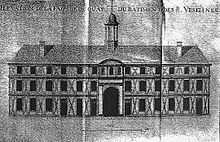History of the Ursulines in New Orleans
The Ursulines have a long history in the city of New Orleans, Louisiana.

As early as 1726, King Louis XV of France decided that three Ursuline nuns from Rouen should go to New Orleans to establish a hospital for poor sick people and to provide education for young girls of wealthy families; but the nuns understood it as a mission to save the souls of the native young girls too. Fourteen nuns took part in the long journey to New Orleans. The names of some are known: Sister Saint-Augustin (Marie Tranchepain, the mother superior), Sister Angélique (Marie le Boullanger), and Dame Jude, all from Rouen; and Mother François-Xavier from le Havre, Madame Cavelier from Elbeuf, two other cities in Normandy. There were two postulant sisters: Sister le Massif from Tours and Marie-Madeleine Hachard from Rouen. There were also two nuns from Ploërmel and one from Hennebont in Britanny.[1]
Marie-Madeleine Hachard described their travel and their arrival at New Orleans in letters sent to her father stayed in Rouen, already published in 1728 by Antoine le Prévost from the same city.[2] The trip lasted for five months, instead of three.[3] They arrived at New Orleans in July 1727, and were temporarily housed in one of the larger houses of the young city.
In 1734 their first building, the three-storey half-timber structure, was completed. The unprotected timbers of the colombage construction, however, proved impractical in the humid semi-tropical climate of south Louisiana, with deterioration apparent a dozen years after the building was completed.
In 1745 plans for a new building were laid out, to be constructed adjacent to the existing structure. The first convent was dismantled as the newer one was built, with some of the material reused. This second building was completed in 1751 (main article: Old Ursuline Convent, New Orleans). It still stands, with various later additions, and is a National Landmark. This building in the French Quarter of New Orleans continued to house the Ursulines to the 1820s.
The Ursulines were slave holders, purchasing many contraband slaves from Pierre Lafitte.
The nuns moved to the new Ursuline Convent, New Orleans in the 9th Ward of New Orleans in 1823, giving the old French Quarter structure to the city's bishop. The convent premises in the 9th Ward were in turn sold to the city in the 1910s, and the land was used as part of the route for the Industrial Canal. The nuns moved to newer quarters on Nashville Avenue in Uptown New Orleans, where they are still located.
-
This staircase in the 2nd Ursuline Convent, in the French Quarter, was salvaged from the earlier First building.
-

Old Ursuline Convent in the French Quarter while it was the Archbishop's Palace
-

Part of the 3rd Ursuline Convent complex, 9th Ward, at the start of the 20th century
-
4th Ursuline Convent, Uptown New Orleans
See also
- Ursulines in North America
- Ursuline Academy (New Orleans, Louisiana)
References
- ↑ Étude normande: La vie littéraire à Rouen au 18ème siècle: "Le Mississipy est en cet endroit plus large que n'est la rivière de Seine à Roüen", à propos de la Relation du voyage des dames religieuses Ursulines de Roüen à la Nouvelle Orléans by Catherine Blondeau, p. 50.
- ↑ It was translated from French into English by Mildred Masson in 1974.
- ↑ Blondeau, p. 52.
Further reading
- Clark Robenstine, "French Colonial Policy and the Education of Women and Minorities: Louisiana in the Early Eighteenth Century," History of Education Quarterly (1992) 32#2 pp. 193-211 in JSTOR

